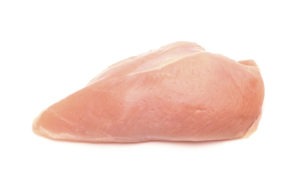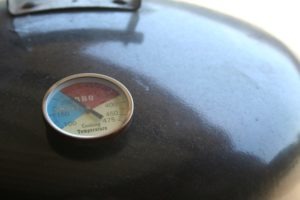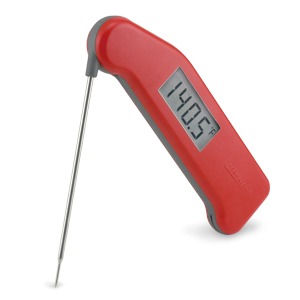Do I Really Need a Thermometer?
As you peruse your cookbook collection or the web looking for recipes or advice on cooking, you may often come across instructions like “cook your chicken until the internal temperature is 165°F,” or “fry the fish in oil preheated to 375°F.” And you might say to yourself “I’ve been doing pretty good work in the kitchen without exact temperatures. How can a thermometer make me a better cook? Do I really need a thermometer?”
Today, I aim to show you that the answer to that questions is a resounding “YES!”
Owning a kitchen thermometer is not about being nit-picky or fussy, it’s about striving for quality and safety in almost everything you cook. If you care about your health, or if you care about how tasty your food is, then you actually do need a fast and accurate digital thermometer in your kitchen.
Thermometers for food safety
The CDC “estimates that each year roughly 1 in 6 Americans (or 48 million people) gets sick, 128,000 are hospitalized, and 3,000 die of foodborne diseases,” and you don’t want to be one of them. By carefully monitoring your food temperatures in all the stages of cooking, you drastically lower the chance of foodborne illness. It’s a fact.

“But I haven’t gotten sick,” you say. Well, there’s a good chance that’s because you’ve been overcooking your food.
Thermometers for food quality
Take chicken, for instance. The USDA informs us that chicken is safe to eat if cooked to—gasp!—157°F (69°C), if held at that temp for 34 seconds. That is well below the sawdust-texture 165°F (74°C) we have all heard before. I can tell you from personal experience, that a chicken so cooked is far juicier and tastier than when cooked all the way to 165°F (74°C), and, as confirmed by the USDA, just as safe!
So we see that food can be cooked to an enjoyable temp, but those margins of enjoyment can be thin. Steak cooked to perfect medium rare is 130-135°F (54-57°C), while steak cooked to medium is 135-145°F (57-63°C), and medium-well is 145-155°F (63-68°C). See how those butt up right against each other? That’s why you need a thermometer. If you want a perfect medium rare steak, or like your steak medium, you have a tiny range of temps in which to pull it from the heat. Finger guessing just isn’t any good when you want it just right!
And if steak isn’t your thing, maybe you like to cook candy, or custard, or craft coffee, all of which have very particular temperature measurements. The fact is, if you want control over the quality of the food you make, you need a thermometer.
Do I really need a digital thermometer?
Yes, if you are serious about any of the above reasons to get a thermometer in the first place, you need a digital thermometer. Thermometers have been with us for hundreds of years, but we have improved upon the original design a lot since their inception, and today’s digital thermometers are way ahead of our grandmothers’ tools.
Why do I need a digital thermometer?
Range
If you already have a thermometer lying around your kitchen, I’d bet you actually have two—one for meat, one for frying or candy making? I thought so. Why do people have two thermometers? Simple. Meat cooks to a relatively low temperature—in the neighborhood of 140°F (60°C)—while boiling sugar and frying oil can get all the way up to 375°F (191°C). A thermometer that is readable and contains all those degree markings would be far too large to use in any home kitchen! Not so with a quality digital! No, a good digital thermometer will have a range from freezing all the way up to deep-fry temps, all in one neat, attractively-designed package.
Accuracy
If I could only mention one area where digital thermometers far excel above analogs, it would be accuracy, And accuracy matters! You don’t want to be 7°F (4°C) off on a steak with a 5°F (3°C) window for doneness. Are dial thermometers that inaccurate? Yes, they can be. They can be thrown off by dropping them, using them at too high a temperature, or getting jostled in your chef sleeve pocket. I took a dial thermometer to a calibration lab to check its accuracy and found it to be 30°F (17°C) low. SO if I was hoping to get my chicken up to 157°F (69°C), I wouldn’t think it was there until 30°F too late. That’s some dry chicken.

Speed
As with accuracy, speed matters. A chicken breast in a hot pan is getting hotter by the second, and if it takes up to 20+ seconds for your “instant read” dial thermometer to attenuate to the temperature, well, that’s more time in the pan getting closer to overcooked. The best digital thermometers get to the temperature in only 2-3 seconds! That’s literally a fraction of the time that it takes to find your temperature with an analog (or with many lesser digital thermometers).
A quick note is in order here about how to take the temperature of a food. A food is only as cooked as its least cooked part, so to find out if your food is done, insert the thermometer almost all the way through the, let’s say, steak, and slowly pull it through, looking for the lowest temperature. That lowest temp is your doneness. (See this bit about how to temp steak.) That’s also why you need a fast thermometer! a slow thermometer can’t cope with the rapidly changing temperature gradients as you pull the thermometer through the food. An accurate but slow thermometer is just as bad as an inaccurate thermometer.
Conclusion: Get yourself a digital thermometer!
So there you have our reasons for in-home thermometry: primarily safety and quality, and beyond those, range, accuracy, and speed in favor of digitization. We hope these points will help you decide that a quality, digital kitchen thermometer is something you need in your life. And if it does, check out some of our top-of-the-line thermometers like the gold-standard Thermapen® or our top-rated, affordable ThermoPop® in our store and improve your cooking today.






Can you still purchase a thermo pop for $20.00?
Margo,
Sadly, that sale has ended. If you aren’t signed up for our emails, you might want to consider it to stay informed of promotions and fun content in the future. Happy cooking!